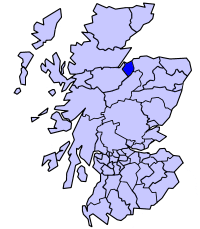
Clan Calder
Encyclopedia

Scottish clan
Scottish clans , give a sense of identity and shared descent to people in Scotland and to their relations throughout the world, with a formal structure of Clan Chiefs recognised by the court of the Lord Lyon, King of Arms which acts as an authority concerning matters of heraldry and Coat of Arms...
. The clan does not currently have a chief
Scottish clan chief
The Scottish Gaelic word clann means children. In early times, and possibly even today, clan members believed themselves to descend from a common ancestor, the founder of the Scottish clan. From its perceived founder a clan takes its name. The clan chief is the representative of this founder, and...
therefore it is considered an Armigerous clan
Armigerous clan
An armigerous clan is a Scottish clan, family or name which is registered with the Court of the Lord Lyon and once had a chief who bore undifferenced arms, but does not have a chief currently recognized as such by Lyon Court...
.
Origins of the Clan
The name Calder is believed to derive from the Scottish name for a small stream. Hugh de Cadella, a French knight was created Thane of Calder, later to be known as CawdorCawdor
Cawdor is a village and parish in Nairnshire, Highland council area, Scotland. The village is situated 5 miles south south west of Nairn, and 12 miles from Inverness.-History:The village is the location of Cawdor Castle, the seat of the Earl Cawdor....
in Nairn, Scotland
Scotland
Scotland is a country that is part of the United Kingdom. Occupying the northern third of the island of Great Britain, it shares a border with England to the south and is bounded by the North Sea to the east, the Atlantic Ocean to the north and west, and the North Channel and Irish Sea to the...
. Hugh de Kaledouer was a witness to a charter of land near Montrose
Montrose, Angus
Montrose is a coastal resort town and former royal burgh in Angus, Scotland. It is situated 38 miles north of Dundee between the mouths of the North and South Esk rivers...
in around 1178.
History
The Calders were great nobles and held lands around the city of InvernessInverness
Inverness is a city in the Scottish Highlands. It is the administrative centre for the Highland council area, and is regarded as the capital of the Highlands of Scotland...
from the 14th century onwards. The tower that stands at the center of Cawdor Castle
Cawdor Castle
Cawdor Castle is a tower house set amid gardens in the parish of Cawdor, approximately 10 miles east of Inverness and 5 miles southwest of Nairn in Scotland, United Kingdom. It belonged to the Clan Calder. It still serves as home to the Dowager Countess Cawdor, stepmother of Colin Robert Vaughan...
was built by the Calders in around 1454.
The Calders married into other local families particularly the Clan Rose
Clan Rose
Clan Rose is a Highland Scottish clan. Their chief's motto is "Constant and True" and their chief'sfamily castle is Kilravock Castle, built in 1460...
who were Barons of Kilravock.
Unfortunately their ascendancy came to an end when Archibald Campbell
Clan Campbell
Clan Campbell is a Highland Scottish clan. Historically one of the largest, most powerful and most successful of the Highland clans, their lands were in Argyll and the chief of the clan became the Earl and later Duke of Argyll.-Origins:...
, Earl of Argyll was along with Hugh Rose
Clan Rose
Clan Rose is a Highland Scottish clan. Their chief's motto is "Constant and True" and their chief'sfamily castle is Kilravock Castle, built in 1460...
of Kilravock appointed guardians to the infant female heir of the Calder family. Campbell tried to take the infant female to Inverary to be educated. This was opposed by her uncles Alexander and Hugh Calder who chased them to Strathnarin but after considerable loss of life she was safely delivered to Inverary. She was brought up as a Campbell and married Sir John Campbell of Argyll.
Muriel the last of the Calders died around 1575 but her descendent John Campbell of Cawdor was raised to the peerage as Lord Cawdor in 1796, and his son was created first Earl of Cawdor in 1827. The name Calder did not die out, however, and the Calders of Asswanly received lands near Elgin in 1440. Margaret Calder the daughter of Sir William Calder of Calder married John Munro, 11th Baron of Foulis
John Munro, 11th Baron of Foulis
John Munro of Foulis was a Scottish clan chief of the highland Clan Munro in Rosshire, Scotland. He is by tradition the 11th Baron of Foulis and 14th overall chief of the clan...
, Chief of the Clan Munro
Clan Munro
-Origins:The main traditional origin of the clan is that the Munros came from Ireland and settled in Scotland in the 11th century and that they fought as mercenary soldiers under the Earl of Ross who defeated Viking invaders in Rosshire...
. The Calders of Asswanly received a baronetcy
Calder Baronets
There have been two Calder Baronetcies.The Calder Baronetcy, of Muirtone in the County of Moray, was created in the Baronetage of Nova Scotia on 5 November 1686 for James Calder...
of Nova Scotia in 1686.

